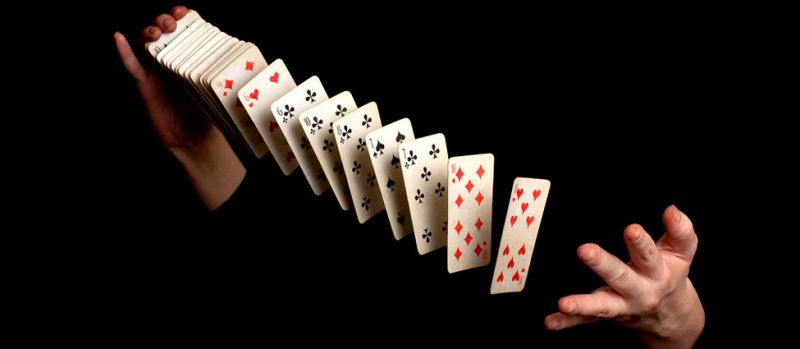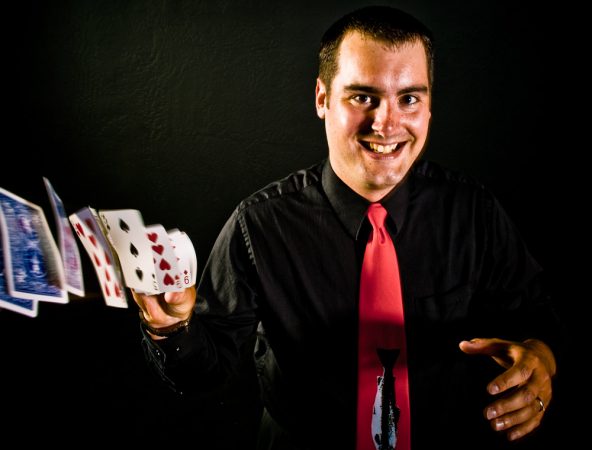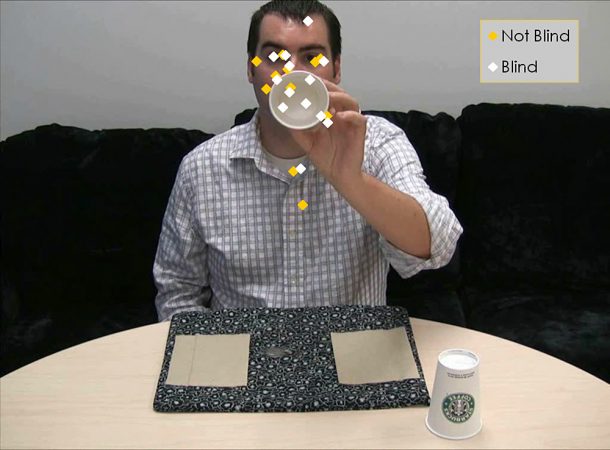Fooling the mind’s eye
Brain scientists find they have much to learn from magicians and their tricks

If you’ve been to a magic show, you’ve almost certainly witnessed the mesmerizing trick in which a showman saws his female assistant in half. The woman lies down, her body seeming to extend the length of the table or some box. The magician seems to lock her inside a compartment (usually with her head and wiggling feet sticking out either end) and begins to saw through the region where her waist is hidden. After several excruciating minutes of suspense, out hops the woman. And her body is intact.
Introduced nearly a century ago, the trick is one of the oldest in the magic business. Over time, the magicians’ methods have grown more sophisticated. But this illusion endures because the vulnerabilities of the human mind are so predictable. Tricks like this one rely on gaps in our perception — how the brain interprets the environment based on information that sensory organs, including the eyes, pick up.
Scientists who study the brain have been tapping into the world of magic to learn how its tricks fool our minds. Emerging in just the past five years, this new discipline is often called neuromagic.
Neuroscientists and psychologists study how the mind works and how emotions can affect our responses. These scientists have begun teaming up with magicians to study how tricks can manipulate critical attention and awareness. This research is beginning to give scientists a window into how the mind could be influenced for more than entertainment — such as improving driver safety or classroom education.
“We study illusions to understand fundamental aspects of visual perception,” says Susana Martinez-Conde, a visual neuroscientist at the Barrow Neurological Institute in Phoenix, Ariz. “These illusions often come from the art world and not from the science world.” This includes magic and visual arts — such as two-dimensional paintings that create the illusion of being three-dimensional.
Martinez-Conde and her husband, Stephen Macknik, also a neuroscientist at The Barrow, are authors of a 2010 book on the subject. The two stumbled upon the marriage of magic and science in 2007 when they organized a conference about the science of consciousness. (When a person is conscious, he or she is fully awake and aware of his or her experiences and surroundings.) At the conference, in Las Vegas, they worked with famous magicians such as Raymond Joseph Teller from the famous team of illusionists Penn & Teller. At once, the scientists were hooked.

A few years later, the researchers auditioned for membership in the Academy of Magical Arts, also known as The Magic Castle, in Hollywood. “We passed. We became magician members of the castle — but we were advised not to give up our day jobs,” laughs Martinez-Conde.
Coping with too much information
People fall for illusions like the sawed-in-half woman because the brain constantly fills in information about the real world in order to make sense of it. For instance, when we see a cow or a horse standing behind a fence post, we automatically “fill in” the part of the animal’s body that is hidden from our sight. Although we see only part of the animal, we assume that the whole animal is present.
Each human eye has a conduit to the brain called the optic nerve. It transmits all of the visual information that the eye takes in. The brain processes these data to fit with reality as we know it.
An optic nerve consists of more than one million axons, or wirelike structures, bundled tightly together. They carry messages in the form of electrical impulses away from neurons, or brain cells. A few million axons may sound like a lot of capacity, Macknik admits. But compare that, he says, to an iPhone with an 8-megapixel camera. The camera has about four times the resolution — the capability to produce detailed images — of both of our eyes together. But the phone still takes poor pictures compared with how the world appears through human eyes. That’s because the brain enriches our perception to make the world appear clearer, explains Macknik.
Our eyes receive a continuous blitz of information about the world — far more than the brain can process. Because we interpret the world with limited resources, we perceive only a small fraction of the available information. Our brains are wired to first sample the edges of objects and then, like a very sophisticated computer, calculate what is inside.
Neurons in a region of the brain called the primary visual cortex can process only the rounded corners and straight edges and lines of objects. What’s “inside” an object — such as a piece of paper — is invisible to these neurons. “So the brain is taking this kind of very sparse information about the world and it’s generating this rich world by filling in information,” says Macknik. “Your brain is doing that with virtually everything you’ve ever seen.”
Without these mental and sensory shortcuts, our brains would have to be hundreds of times bigger to actually process all of the information about our world that we seem to. The brain can remain small if it needs to create only a simulation of the world, rather than trying to process every true detail about it.
But since our brains are filling in the gaps, sometimes they get it wrong.
Because we expect the cow behind the fence post or the woman’s body in the box onstage to be continuous, we assume that it is. It’s these usually correct but sometimes-faulty assumptions that magicians have learned to exploit.
“Illusions are where we can see the cracks in the plaster of the world our brains have built for us,” says Martinez-Conde.
Missing what’s in plain sight
Magicians rely on the brain’s tendency to perceive objects as continuing in the expected direction. This tendency explains magicians’ success in fooling people with well-known tricks using strings, ropes, rings, spoons and dollar bills. For instance, research by Martinez-Conde and Macknik has shown that when you see a magician toss a coin up and down in one hand and then fake a coin throw to the other hand, spectators actually “see” the nonexistent coin flying from one hand to the other. This trick works well only when the spectator sees the coin actually being tossed up and down prior to the fake throw. Without that setup, the spectator is more likely to notice that the coin was not actually thrown from one hand to the other.
“Performing magic makes you keenly aware of how fallible peoples’ perceptions are,” notes Anthony Barnhart. He’s a professional magician and a doctoral student in cognitive psychology at Arizona State University in Tempe. By fallible, he means capable of being wrong. “So much of what you think you’re perceiving, you’re really misperceiving,” he says. That’s because your previous experiences drive so many of your perceptions. You expect things to proceed as they have in the past.

Barnhart began doing magic at age 7, and he says it’s what drove him toward the field of psychology. In the laboratory, Barnhart now uses magic as a tool to study attention and perception.
He designed one trick to study “blind spots” in our attention. In a video, Barnhart shows viewers a silver coin before setting it on a place mat with a busy print. He covers the coin with a napkin, and places another napkin beside the first. In plain sight of the viewers, the silver coin slides across the mat and beneath the second napkin. (The coin sits atop a small patch of fabric that blends in with the mat. Barnhart tugs on an invisible string connected to the fabric, moving it — and the coin — across the mat.)
At the same time the coin is moving, Barnhart looks inside of a cup and then shows the audience the empty contents of it. This focuses viewers’ attention on him and the cup instead of on the coin. He places that cup atop the first napkin. Then he sets another cup onto the second napkin. When he lifts both cups, many viewers are surprised to realize the coin is not where they thought it was.
In the lab, about half of the viewers see the coin move; the other half do not. (Full disclosure: When shown the video, this writer did not see the movement of the coin the first time — nor the second.) So far, Barnhart has performed the trick only once for a live audience of both magicians and scientists. He estimates that then just 1 in 10 viewers perceived the coin sliding across the mat.
Barnhart’s trick is a small-scale demonstration of a well-known experiment called the “invisible gorilla.” In this experiment, a spectator watches a video or live demonstration of two teams of basketball players. Viewers are instructed to count how many times the team wearing white shirts passes the ball. While the spectators are focused on their task, a person dressed in a gorilla suit walks into the middle of the court, beats their chest, then exits. Shockingly, about half of the spectators never see the gorilla, even when their eyes appear to be looking directly at it.

The perils of misdirection
Such a blind spot is nearly impossible to prevent — at least until we are familiar with the trick that’s behind it.
Experiments like the invisible gorilla and Barnhart’s moving coin are “a strong demonstration of the fact that you are unaware of most of the stimulation that falls on your eyes and ears as well,” says Barnhart. These tricks help scientists understand what types of stimuli in our environment are likely to capture our attention. And understanding how attention can be manipulated under natural conditions could have long-term applications, for example, in improved design of airplane cockpits. “There have been lots of instances where airline pilots have been blind to blinking or beeping things that should have captured their attention,” he says.
The key to Barnhart’s success with the coin trick is his show of looking inside the cup. It draws the audience’s attention toward the first cup — and away from the coin.
Magicians employ this tactic, what they call “misdirection.” It underlies most sleight-of-hand tricks, such as pulling a specific card from a deck or making a surprising object appear. Like a magnet, distractions strongly pull our attention exactly to where the magicians want it.
Scientists who study attention frequently compare it to a spotlight. By moving our spotlight of attention to the wrong place, magicians can cause us to miss a secret action during sleight of hand.
Barnhart takes this analogy one step further: Research is beginning to show that our attention is more like a spotlight that blinks at some regular frequency, almost like a traffic light that is malfunctioning. Magicians can use music and other tactics, including jokes and gestures, to control when a person’s attention — or spotlight — turns on or off. A magician succeeds when he or she turns off our attention spotlights, at least temporarily, and we don’t know it. It’s at this point, he says, that conjurers “can get away with murder — and the audience won’t see it.”
But Barnhart says there is a way to beat the system. “One way to potentially overcome this sort of misdirection and all the tricks magicians use is to disengage from the actual story that the magician is telling you,” he advises.
Beyond entertainment
Understanding the science behind misdirection could have applications far beyond the magician’s stage. One area of research that Martinez-Conde and Macknik find promising is the interaction between attention and emotion.
Magicians have perfected the use of comedy to elicit emotions from their audience at the precise moment when it is most beneficial to create a deception or illusion. Such an ability could be useful in the rehabilitation of people who have suffered brain trauma and those who have trouble paying attention or are easily distracted, says Macknik.
For instance, a therapist might use the tools of magic. A story, comedy — even rhythm and music might be used to help brain-damaged patients focus their attention on the most critical points of their therapy. Similarly, such approaches might help children pay more attention to the most important parts of a class presentation.
Another avenue of Martinez-Conde’s research involves studying the tiny eye flutters that occur when people are concentrating. She hopes to apply this research to understanding how these eye movements might differ in people suffering from memory decline, such as Alzheimer’s patients. Those differences might one day be used to diagnose brain disease in its early — and potentially treatable —stages.
“We have the best of both worlds,” Martinez-Conde says: “the ability to answer very important scientific questions — and have a lot of fun at the same time.”
Power Words:
Alzheimer’s A disease in which the brain undergoes gradual degeneration, resulting in loss of memory and other cognitive skills.
axon A long nerve fiber that extends from a nerve cell, or neuron, and that transmits information (encoded in electrical impulses) away from the body of that cell.
consciousness The state of being fully awake and aware of one’s existence, thoughts and surroundings.
illusion Something that deceives or misleads the mind.
neuron A nerve cell that processes and transmits electrical and chemical signals in the brain.
neuroscience The study of the nervous system.
optic nerve A nerve made from more than one million fibers. It conveys visual information from the eyes to the brain.
perception How the brain interprets the environment based on information from sensory organs, such as the eyes.
primary visual cortex An area in the back of the brain that receives and interprets visual information, such as moving objects and patterns.
psychology The science of the mind and behavior.
sleight of hand A trick, usually performed with the hands, that uses misdirection to deceive viewers.
trauma A wound or other type of injury to the mind or body.







